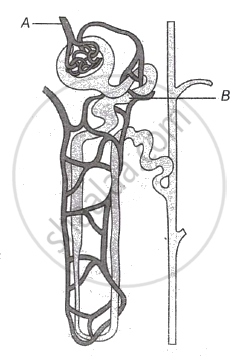Advertisements
Advertisements
Question
Answer the following in detail.
Describe the process of urine formation.
Solution
The process of urine formation takes place in the following steps:
- Glomerular Alteration: Blood containing waste material enters the kidneys through the renal artery. It then enters the glomerulus under high pressure. Water and small solutes are filtered in the Bowman’s capsule.
- Tubular reabsorption: Filterate passes through the thin walls of the Bowman’s capsule into the urinary or renal tubule. As it passes through the tubule, water, and many useful substances are reabsorbed by the renal blood capillaries.
- Tubular secretion: The remaining liquid, along with wastes such as urea, uric acid, etc., is called urine and is collected in the urinary bladder.
- Excretion: Urine leaves the kidneys and passes into the urinary bladder through the ureters. When the urinary bladder is full, urine is passed out through the urethra.
APPEARS IN
RELATED QUESTIONS
Draw the well-labelled diagram of the human excretory system
What job is done by the kidneys?
What is the name of the tubes which connect the kidneys to bladder?
Choose the correct answer:
Composition of extracellular fluid is regulated by ___________
Choose the odd one out in the following serie:
Column of Bertini, minora calyces, brain.
Draw a labeled diagram of the human kidney as seen in a longitudinal section.
Hypotonic filtrate is formed in _______.
Answer the following question.
Name any one guanotelic organism.
If a plant is releasing carbon dioxide and taking in oxygen during the day, does it mean that there is no photosynthesis occurring? Justify your answer.
Identify the correct labels for A and B in the following diagram

